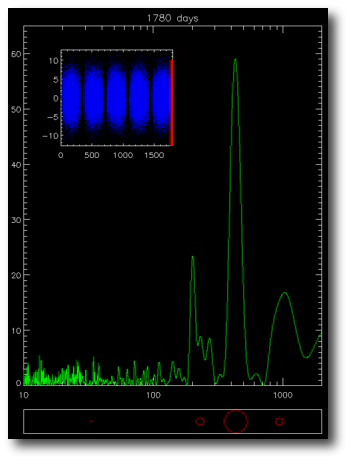
Image Source.
Yesterday, I gave a talk at the JPL Exoplanet Science and Technology Fair, a one-day meeting that showcased the remarkably broad variety of extrasolar planet-related research being carried out at JPL. In keeping with the wide array of projects, the agenda was fast-paced and completely diverse, with talks on theory, observation, instrumentation, and mission planning.
The moment I walked into the auditorium, I was struck by the out-there title on one of the posters: The Ultimate Project: 500 Years Until Phase E, from Sven Grenander and Steve Kilston. Their poster (pdf version here) gives a thumbnail sketch of how a bona-fide journey to a nearby habitable planet might be accomplished. The audacious basic stats include: 1 million travelers, 100 million ton vessel, USD 50 trillion, and a launch date of 2500 CE.
Fifty trillion dollars, which is roughly equivalent to one year of the World GDP, seems surprisingly, perhaps even alarmingly cheap. The Ultimate Project has a website, and for always-current perspective on interstellar travel, it pays to read Paul Gilster’s Centauri Dreams weblog.
Interest in interstellar travel would ramp up if a truly Earth-like world were discovered around one of the Sun’s nearest stellar neighbors. Alpha Centauri, 4.36 light years distant, has the unique allure. Last year, I wrote a series of posts [1, 2, 3, 4] that explored the possibility that a habitable world might be orbiting Alpha Centauri B. In short, the current best-guess theory for planet formation predicts that there should be terrestrial planets orbiting both stars in the Alpha Cen binary. In the absence of non-gaussian stellar radial velocity noise sources, these planets would be straightforward to detect with a dedicated telescope capable of 3 m/s velocity precision.
Over the past year, we’ve done a detailed study that fleshes out the ideas in those original oklo posts. The work was led by UCSC graduate student Javiera Guedes and includes Eugenio, Erica Davis, myself, Elisa Quintana and Debra Fischer as co-authors. We’ve just had a paper accepted by the Astrophysical Journal that describes the research. Javiera will be posting the article to astro-ph in the next day or so, but in the meantime, here is a .pdf version.
Here’s a diagram that shows the sorts of planetary systems one should expect around Alpha Cen B. The higher metallicity of the star in comparison to the Sun leads to terrestrial planets that are somewhat more massive.

We’re envisioning an all-out Doppler RV campaign on the Alpha Cen System. If the stars present gaussian noise, then with 3 m/s, one can expect a very strong detection after collecting data for five years:

Here’s a link to an animation on Javiera’s project website which shows how a habitable planet can literally jump out of the periodogram.
I think the planets are there. The main question in my opinion is whether the stellar noise spectrum is sufficiently Gaussian. It’s worth a try to have a look…

Fascinating. I hope you’re right and the planets are there–it certainly is worth a try. Do we have the equipment with the sensitivity to give it a go now?
I suspect that except for the confirmed discovery of an Earth twin somewhere, it will probably be *the* exoplanet discovery that grabs the headlines. After all there would be something extra special about discovering that our nearest neighbor has its own planets.
As for “The Ultimate Project”, well, given how far we’ve come in the past 500 years (1508 people!) I guess it’s a brave soul who would dare to predict the state our our world, let alone the state of our technology 500 years hence. There’s no harming in dreaming, I guess, but it seems to me that unless there is a planet-wide crisis to drive it, there will be little incentive to drive the project within that time frame.
I think you’re correct in inferring that if we discover a habitable planet next door then perhaps there would be more hope for such an ambitious project (though only after several scouting missions and advanced parties first!).
But I suspect there will be more efficient ways of transporting a million human beings by then. Given that it is expected to be a generational ship, why not freeze a million embryos and sail with a skeleton crew of a few hundred? Much cheaper!
500 years? Someone should tell them about the Singularity…
The whole Singularity thing strikes me as the kind of extrapolation that predicted hypersonic steam ships.
Pingback: Centauri Dreams » Blog Archive » Detecting Centauri Planets
Hi Greg,
sorry for this naive question, but why do you always focus on Alpha Cen B planets, rather than in Alpha Cen A ? I can understand that the planet/star mass ratio makes detection simpler for Alpha Cen B. Is this the reason or is there something else like the chromospheric stability of Alpha Cen B, that would make the signal of an orbiting planet standout more clearly ?
Are you going to go ahead with this and try to fund raise the money for this project ?
Cheers,
Luis
Hi again,
please forget the first part of my question. I finally had the time to read the paper and it is all there… sorry.
Cheers,
Luis
One of the interesting questions is whether planets form around more than one component of a multiple star system. Closest thing currently known to such a configuration is probably HD 41004, but the companion to HD 41004B is in the brown dwarf mass range.
Hi Luis,
Thanks for the question. Debra Fischer is leading an effort to fund a special-purpose telescope in the southern hemisphere to carry out the experiment. I’ll be sure to post any news as it arises…
best,
Greg
What are the predicted volatile contents of planets around the Alpha Centauri stars? I have seen several simulations of planet formation in the system, but none of them explicitly include delivery of volatiles.
Andy,
We already have one… the fascinating PSR 1620-26 system contains a giant planet orbiting an inner pulsar-white dwarf pair.
(e.g., http://adsabs.harvard.edu/cgi-bin/nph-data_query?bibcode=2000ApJ…528..336F&db_key=AST&link_type=ABSTRACT&high=464214facd14693 and http://adsabs.harvard.edu/cgi-bin/nph-data_query?bibcode=2005ASPC..328..213S&db_key=AST&link_type=ABSTRACT)
Hi Andy,
Currently, the 55Cnc stellar system (55Cnc A and B) may be the most interesting binary system that hosts planets (for at least one reason). The A component, the one with 5 known planets, has a high metallicity. Assuming that both stars formed out of the same cloud with a supposedly uniform metal content, it would be very interesting if planets are not found around the B component.
Eugenio
eford: I was thinking of planets in S-type orbits, with one set of planets orbiting star A, and another set orbiting star B, rather than P-type or circumbinary planets, which present another interesting environment which has not yet been well investigated. (Maybe HD 202206 falls into the circumbinary planets category too, and there was a recent paper about a possible planet around CM Draconis)
Eugenio: how difficult would it be to get good enough radial velocity measurements from, say, 55 Cnc B or Ups And B to detect planets? Presumably the proximity of the brighter primaries would pose a problem.
I believe Ms Guedes’ paper mentioned that the orbital plane of planets in binaries is likely to be similar to the orbital plane of the binary system. I wonder if the radial velocity sets obtained by the major telescopes include unpublished evidence against major planets in the binary companions of stars that harbor planets. It would be interesting to know more about the stars that have been targeted and have no appreciable radial velocity signals.
BTW – it was nice to see the reference to a Systemic paper in progress. You’ve had quite a few publications recently.
Chris
Hi Andy,
For the stellar companions of 55Cnc and Ups And, the problem is not the relative proximity of the primaries. For both of these systems and for almost all the binary systems that host planets, the companions are sufficiently separated that none (or at least an insignificant amount) of the light from the primary should enter the slit when the secondary is observed. The primary issue for the secondaries of 55Cnc and Ups And is their faintness. It simply takes more time to get a good spectrum (many well-defined, sharp absorption lines) for a dim star than for a bright star. Radial velocity surveys have tended to observe as many stars as possible on each night of observations. Since dim stars take more time to observe, which reduces the total number of observed stars, the dimmer stars generally do not have as many (high quality) radial velocity measurements as the brighter stars. Thus, it simply takes more time to get enough high quality radial velocity measurements (for the observers to be confident that they have found a planet) for the dim stars than for the bright ones — because they are dim and because they are not observed as frequently.
Eugenio
So what does this prospect exist at the moment?
Are you going to attempt to get this 5-year commitment underway? And if so, when do you think it could start? Needless to say, I’m quite excitedly waiting for developments on this. Who wouldn’t like to see a handful of terrestrial planets around Alf Cen B? Is a proposal in writing? or what?
NB i see the terrestrial range of “0.5-1.5 AU” being bandied about, here. no way!
due to the thermal impact of star A, that moves the habitable zone considerably farther out. i don’t have my numbers in front of me, but just consider what the graybody temperature of Uranus is & add this to Earth’s (plus, it’s a brighter sun). i think we should be looking 2 to 3 AU out from B for a planet that’s not runaway greenhousing. (even moreso, for planets of
star A.) in this system we really are pushing the edge of what’s dynamically stable…
m.
graywyvern – you need to add fluxes not temperatures, which means you raise the two temperatures to the fourth power and add them, then take the fourth root.
If you do that, you find that Alpha Centauri A’s contribution to the temperature of an HZ planet around Alpha Centauri B is a few tenths of a degree, so the habitable zone is pretty much in the same place as it would be if the star was single.
Pingback: Blog de Astronomia do astroPT » Planetas telúricos em Alfa Centauri B ?
Hi Everyone,
Debra Fischer has received NSF funding to begin a design study for the Alpha Cen project. The first observing run starts May 19th on an underutilized 1.5-m telescope at the CTIO in Chile.
This first run will largely be an engineering run, and Debra and Javiera will be working with Andrei Tokovinin (a collaborator and staff scientist at CTIO) who is refurbishing an echelle spectrometer for the project.
In parallel with the NSF-funded groundwork, Debra is also leading a fund-raising effort to fund the full 5-year project.
So things are definitely moving forward…
Why do you need to be in Chile for such a bright star? Couldn’t you use a historical observatory somewhere like Hobart of Cape Town?
For that matter, Mt. Stromlo in Canberra has a redevelopment fund for bushfire recovery. Why not use a replacement telescope there- it would be a great high-profile project for the rebuild.
It’s true that South Africa and Australia are equally well positioned. Chile was first choice due to the relationships and infrastructure that are already established.
It would be excellent if two independent sites carried out the experiment.
Pingback: systemic - Hawaii
Pingback: Crowlspace » Blog Archive » Gliese 436c
Pingback: Interstellar Travel Destinations « Gravity Loss
Pingback: Populär Astronomi - » Oenigt om närmaste stjärnans planeter